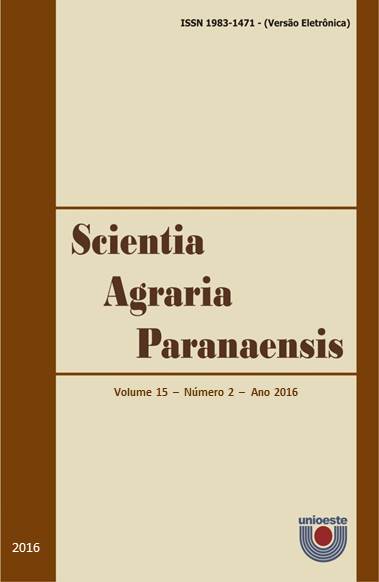Volatile effect of essential oils on the growth of pathogens in almonds of Brazil nuts
DOI:
https://doi.org/10.18188/sap.v15i2.10792Keywords:
Aspergillus sp., Bertholletia excelsa, controle alternativo, Penicillium sp., Rhizopus sp.Abstract
Due thea system of extractive harvest of almonds of Brazil nuts is necessary care in the phytosanitary area to maintain postharvest quality of the product. Therefore, we assessed the effect of volatile essential oils of clove (Syzygium aromaticum), cinnamon (Cinnamomum cassia), rosemary (Rosmarinus officinalis) and eucalyptus (Corymbia citriodora) in the development of fungi in almond of Brazil nuts, collected in Itaúba, MT State, Brazil. The design was completely randomized factorial with five treatments in five replicates. We used 100 µL of oils, added on a filter paper on a slide glass in the center of Petri dishes with five almonds around. The plates were sealed and kept at 25 ± 2 °C/dark. Two evaluations (five and ten days after incubation) of incidence and severity of fungi were performed. It was observed incidence of Aspergillus niger, A. flavus, Rhizopus sp. and Penicillium sp. Eucalyptus oil was effective in the inhibition of Penicillium sp. while clove oil showed greater inhibition of Rhizopus sp.; and cinnamon inhibited A. niger and A. flavus, Rhizopus sp. and Penicillium sp. The essential oil of rosemary stimulated the development of all fungi. The severity of fungi in nuts treated with cinnamon oil was 9.5%, whereas in the treatment with clove, eucalyptus and rosemary oils the severity were 22.52%, 24.72% and 38.2%, respectively. We conclude that the essential oils of cinnamon, clove and eucalyptus have volatile compounds that inhibit the growth of some fungi in almond of Brazil nuts, and cinnamon oil was more efficient.
Downloads
Published
How to Cite
Issue
Section
License
Aviso de Direito Autoral Creative Commons
Política para Periódicos de Acesso Livre
Autores que publicam nesta revista concordam com os seguintes termos:
1. Autores mantém os direitos autorais e concedem à revista o direito de primeira publicação, com o trabalho simultaneamente licenciado sob a Licença Creative Commons Attribution que permite o compartilhamento do trabalho com reconhecimento da autoria e publicação inicial nesta revista.2. Autores têm autorização para assumir contratos adicionais separadamente, para distribuição não-exclusiva da versão do trabalho publicada nesta revista (ex.: publicar em repositório institucional ou como capítulo de livro), com reconhecimento de autoria e publicação inicial nesta revista.
3. Autores têm permissão e são estimulados a publicar e distribuir seu trabalho online (ex.: em repositórios institucionais ou na sua página pessoal) a qualquer ponto antes ou durante o processo editorial, já que isso pode gerar alterações produtivas, bem como aumentar o impacto e a citação do trabalho publicado (Veja O Efeito do Acesso Livre).
Licença Creative Commons
Esta obra está licenciada com uma Licença Creative Commons Atribuição-NãoComercial-CompartilhaIgual 4.0 Internacional, o que permite compartilhar, copiar, distribuir, exibir, reproduzir, a totalidade ou partes desde que não tenha objetivo comercial e sejam citados os autores e a fonte.


